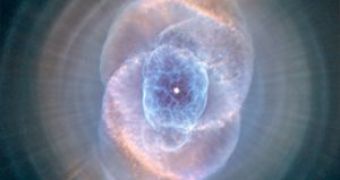Scientists think they could forecast the fate of our Solar System in several billion years, after investigating within the constellation Virgo an unusual ring of metal-rich gas around a white dwarf (the remains of a burned-out small star).
The white dwarf, called SDSS 1228+1040, sits about 463 light-years from our solar system.
The solar remnant may have formed from a star that was about four to five times as big as the sun. The impacts between at least one planet and an asteroid at a great distance from the white star are responsible for the ring of metal-rich gas.
This process could point into how our solar system will eventually die. When small to medium stars finish all their hydrogen, they expand like balloons into ?red giants?, destroying everything in their path. Red giants can grow hundreds to thousands of times the size of our sun.
After that, the outer layers of a red giant vanish and leave behind a dense core, a white dwarf that has a mass of our sun in a body the size of Earth. The red giant of SDSS 1228+1040 probably destroyed everything in its orbit out to about 500 million miles (800 million kilometers), that's why the gas disk is curiously too close to the white dwarf. "The stuff we see [in the disk] can't have been there before," said Boris Gansicke, an astrophysicist at the University of Warwick in the United Kingdom. "It must have been brought to this place after the white dwarf formed."
The researchers think that the gas originated from a 30-mile-wide (50-kilometer-wide) asteroid that was kicked out of a stable orbit by an interaction with a large planet. The larger planet pushed the asteroid close enough to the white dwarf to be broken up by the star's gravity. "It was just shredded to pebbles, and the white dwarf is quite hot still, so the material got evaporated to form the disk," Gansicke said.
Astronomers think this will be also the faith of Solar Systems in a few billion years. ?During our sun's red giant phase, the inner planets Mercury, Venus, and probably Earth will be destroyed,? Gansicke noted.
The swelling sun will lose about half its mass, and its weakened gravitational force will allow Mars and the outer planets to escape to wider orbits.
When the sun will be a white dwarf, one of the asteroids in the asteroid belt may be pushed out of orbit by Jupiter's gravity closer to the dead star, following the same process as the one that approached to SDSS 1228+1040. "We believe in five to eight billion years, the solar system will look very much like the white dwarf" in Virgo, Gansicke said. "It will mainly have the asteroids going around it and a couple of planets."

 14 DAY TRIAL //
14 DAY TRIAL //